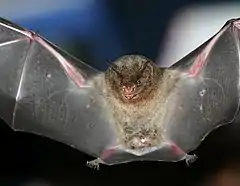| Carolliinae | |||
| G.S. Miller, 1924[1] | |||
 Przedstawiciel podrodziny – karolia jedwabista (Carollia brevicauda) | |||
| Systematyka | |||
| Domena | |||
|---|---|---|---|
| Królestwo | |||
| Typ | |||
| Podtyp | |||
| Gromada | |||
| Podgromada | |||
| Infragromada | |||
| Rząd | |||
| Podrząd | |||
| Nadrodzina | |||
| Rodzina | |||
| Podrodzina |
karolie | ||
| Typ nomenklatoryczny | |||
|
Podrodziny: Carollia J.E. Gray, 1838 | |||
| Synonimy | |||
| |||
| Rodzaje i gatunki | |||
| |||
Karolie[7] (Carolliinae) – monotypowa podrodzina ssaków z rodziny liścionosowatych (Phyllostomidae).
Zasięg występowania
Podrodzina obejmuje gatunki występujące od Meksyku przez Amerykę Centralną i Południową do północnej Argentyny[8][9][10].
Morfologia
Długość ciała (bez ogona) 48–79 mm, długość ogona 5–16 mm, długość ucha 11–22 mm, długość tylnej stopy 8–17 mm, długość przedramienia 33,7–45 mm; masa ciała 11–25 g[9][11].
Systematyka
Rodzaj zdefiniował w 1924 roku botanik i zoolog Gerrit Smith Miller w artykyle poświęconym nowym ssakom Ameryki Północnej opublikowanym na łamach Bulletin of the United States National Museum[1]. Na gatunek typowy wyznaczył (oznaczenie monotypowe) karolię okularową (C. perspicillata).
Etymologia
- Carollia: łac. Carollia ‘Karol’; prawdopodobnie uhonorowanie Karola Lucjana Bonapartego (1803-1857), francuskiego zoologa i ornitologa[12].
- Hemiderma: gr. ἡμι- hēmi- ‘pół-’, od ἡμισυς hēmisus ‘połowa’; δερμα derma, δερματος dermatos ‘skóra’[13]. Gatunek typowy (oznaczenie monotypowe): Phyllostoma brevicaudum Schinz, 1821.
- Rhinops: gr. ῥις rhis, ῥινος rhinos ‘nos’; ωψ ōps, ωπος ōpos ‘twarz’[14]. Gatunek typowy (oznaczenie monotypowe): Rhinops minor J.E. Gray, 1866 (= Phyllostoma brevicaudum Schinz, 1821).
Podział systematyczny
Do podrodziny należy jeden rodzaj karolia[7] (Carollia) z ośmioma gatunkami[15][11][8][7]:
- Carollia benkeithi Solari & R.J. Baker, 2006 – karolia amazońska
- Carollia castanea H. Allen, 1890 – karolia kasztanowa
- Carollia subrufa (Hahn, 1905) – karolia szarawa
- Carollia manu Pacheco, Solari & Velazco, 2004 – karolia peruwiańska
- Carollia sowelli R.J. Baker, Solari & F.G. Hoffmann, 2002 – karolia środkowoameryka
- Carollia brevicauda (Schinz, 1821) – karolia jedwabista
- Carollia monohernandezi Muñoz, Cuartas & M. González, 2004 – karolia leśna
- Carollia perspicillata (Linnaeus, 1758) – karolia okularowa
Uwagi
Przypisy
- 1 2 G.S. Miller. List of North American recent mammals. „Bulletin of the United States National Museum”. 128, s. 53, 1924. (ang.).
- ↑ G.S. Miller. The families and genera of bats. „Bulletin of the United States National Museum”. 57, s. 144, 1907. (ang.).
- ↑ M.C. McKenna & S.K. Bell: Classification of mammals above the species level. Nowy Jork: Columbia University Press, 1997, s. 311. ISBN 978-0-231-11013-6. (ang.).
- ↑ P. Gervais: Expédition dans les parties centrales de l’Amérique du Sud: de Rio de Janeiro à Lima, et de Lima au Para. T. 1: Mammifères. Paris: Chez P. Bertrand, 1855, s. 43. (fr.).
- ↑ J.E. Gary. Revision of the Genera of Phyllostomidæ, or Leaf-nosed Bats. „Proceedings of the Zoological Society of London”. 1866, s. 115, 1866. (ang.).
- ↑ J.E. Gray. A Revision of the Genera of Bats (Vespertilionidæ), and the Description of some new Genera and Species. „Magazine of Zoology and Botany”. 2, s. 488, 1838. (ang.).
- 1 2 3 Nazwy zwyczajowe za: W. Cichocki, A. Ważna, J. Cichocki, E. Rajska-Jurgiel, A. Jasiński & W. Bogdanowicz: Polskie nazewnictwo ssaków świata. Warszawa: Muzeum i Instytut Zoologii PAN, 2015, s. 161. ISBN 978-83-88147-15-9. (pol. • ang.).
- 1 2 C.J. Burgin, D.E. Wilson, R.A. Mittermeier, A.B. Rylands, T.E. Lacher & W. Sechrest: Illustrated Checklist of the Mammals of the World. Cz. 2: Eulipotyphla to Carnivora. Barcelona: Lynx Edicions, 2020, s. 174–176. ISBN 978-84-16728-35-0. (ang.).
- 1 2 S. Solari, R. Medellín, B. Rodríguez-Herrera, V. da Cunha Tavares, G. Garbino, M.A. Camacho, D.T. Saá, B. Lim, J. Arroyo-Cabrales, A. Rodríguez-Durán, E. Dumont, S. Burneo, L.F. A. Urioste, M. Tschapka & D. Espinosa: Family Phyllostomidae (New World Leaf-nosed Bats). W: D.E. Wilson & R.A. Mittermeier (redaktorzy): Handbook of the Mammals of the World. Cz. 9: Bats. Barcelona: Lynx Edicions, 2019, s. 335–338. ISBN 978-84-16728-19-0. (ang.).
- ↑ D.E. Wilson & D.M. Reeder (redaktorzy): Genus Carollia. [w:] Mammal Species of the World. A Taxonomic and Geographic Reference (Wyd. 3) [on-line]. Johns Hopkins University Press, 2005. [dostęp 2021-02-15]. (ang.).
- 1 2 Class Mammalia. W: Lynx Nature Books: All the Mammals of the World. Barcelona: Lynx Edicions, 2023, s. 503–504. ISBN 978-84-16728-66-4. (ang.).
- ↑ Palmer 1904 ↓, s. 161.
- ↑ Palmer 1904 ↓, s. 317.
- ↑ Palmer 1904 ↓, s. 607.
- ↑ N. Upham, C. Burgin, J. Widness, M. Becker, C. Parker, S. Liphardt, I. Rochon & D. Huckaby: Treeview of Mammalian Taxonomy Hierarchy. [w:] ASM Mammal Diversity Database (Version 1.11) [on-line]. American Society of Mammalogists. [dostęp 2023-01-15]. (ang.).
Bibliografia
- T.S. Palmer. Index Generum Mammalium: a List of the Genera and Families of Mammals. „North American Fauna”. 23, s. 1–984, 1904. (ang.).